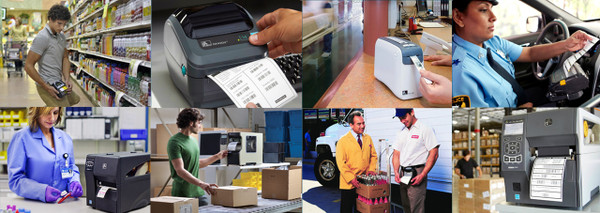What to consider when buying Thermal Label Printers?
Posted by barcodes.com.au on Aug 17, 2018
Thermal Label Printer Features & Benefits
Whether you are working in a warehouse, manufacturing, retail, healthcare or office environment, you will likely need a label printer at some point. Not only they are useful in labelling and identifying products but can play a major role in organising and managing products.
There is a range of label printers available in the market today and the possibilities seem to be endless. If you have no idea which ones best suit your needs choosing the right Label printer can be overwhelming. Each printer is packed with features and benefits they can offer. It’s important you do some research prior to making a decision to make sure you won’t miss out of the great features some printers have.
Some features a label printer can offer
LCD Display
Internal Memory
High Speed Printing
Mobile Printing
Automatic Label Cutter
Ability to work with a variety of label sizes
Label size and label Life requirement
If you know the maximum label width you need, choose a printer that can print this size. For example the most popular printers print labels upto 104 mm wide.
Direct thermal or Thermal transfer plays an important part when it comes to the label life time. Each technology has its own pros and cons. Read our Blog on the Differences between Direct thermal and thermal transfer to determine which technology suits you depending on how long you wish the label to last and if they will be exposed to weather conditions or extreme temperatures.
Printer Resolution
Printer resolution is measured in DPI (Dots per Inch). If you are printing labels for any product that is displayed for retail purchase, then your label will have a barcode on it and barcodes require clarity in order to be scanned and read by Barcode Scanners.
Traditional 203 dpi printers are great for text, numbers and codes. If you are using your labels strictly for barcodes or low resolution images a 203 dpi printer will do the job.
Printers that have a high resolution such as 300 dpi or 600 dpi allow more information to be squeezed into limited label space and improve barcode scan ability, but are expensive compared to traditional 203 dpi barcode printers. It’s also the best way to produce 2D barcodes.
Printer Size, Volume and Speed
The size of the printer (Mobile, Desktop, Industrial) depends on the volume of printing that’s done per day and if the printer needs to be portable. Some label printers are designed to handle a heavy volume of label output, while others are best suited for the small run. When it comes to larger volumes the printing speed matters as you don’t want to slow down the production if your printer can’t keep up with a higher volume.
Long term cost, maintenance and operational costs.
Some people tend to opt for the first printer that fits their budget. In the long run however, there will be instances where it will cost more in the long run. It’s important to keep it mind that not only the initial cost of a printer is important, but the annual cost of replacing ink cartridges, ribbons and regular maintenance etc.
Another important thing to keep in mind regarding overall cost is spec when it comes to cost is to set up the printer and if training is required how long it will take to train the staff. Most likely there won’t be a full time technician available or sometimes no IT department either. So it’s ideal to choose a printer that is simple and easy to maintain. And also user friendly and straight forward.
Make a point to find out whether your retailer offers any inclusive or additional technical support if any issues arise.
Connectivity Options
If you are connecting the printer to a PC then a USB, connection is the most popular. If you need a printer that allows multiple users to connect at the same time then you will be exploring more printers that offer Ethernet (LAN) connectivity. If you are carrying the printer and therefore want it to be portable, the printer needs to be able to pair to a PC or a mobile device such as a smart phone or a tablet via Bluetooth or WiFi connectivity.
Lastly how do you design the labels? Most printers come with a basic label design software. However it may have limitations. We recommend Bartender Label software to design labels. Bartender’s four editions support a wide range of printing and marking solutions, from small, stand-alone environments to large, automated infrastructures that are integrated with major ERP applications from Oracle, SAP, IBM and others. It allows users to create labels such as address labels, product description labels, shipping labels, barcode labels and also create cards and RFID Tags.
Click here to read our blog which explains the differences between Bartender Software Editions.
Having an organised office and streamlined processes at the workplace can boost productivity and simply make things easier to identify and manage. With a range of label printers available online, understanding which meets the demands of your organisation can be a challenge. Having considered the standard of the printer that fits your requirement, print technology that’s necessary for the label life requirements, you are now able to make informed decisions as to which label printer best suits you.

